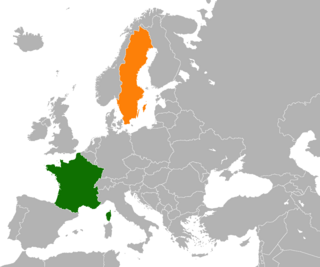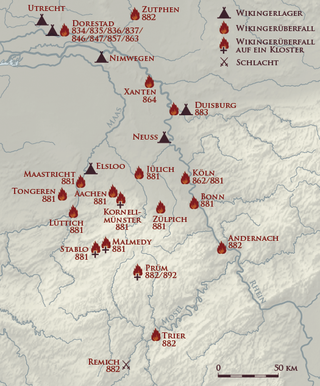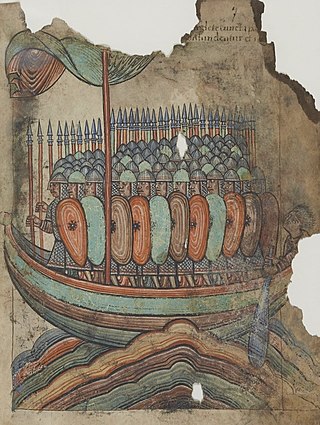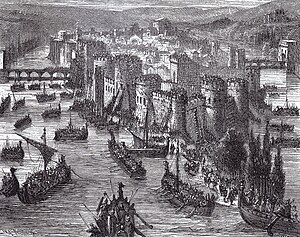The 830s decade ran from January 1, 830, to December 31, 839.
The 840s decade ran from January 1, 840, to December 31, 849.
The 850s decade ran from January 1, 850, to December 31, 859.

Year 845 (DCCCXLV) was a common year starting on Thursday of the Julian calendar.

Charles the Bald, also known as Charles II, was a 9th-century king of West Francia (843–877), King of Italy (875–877) and emperor of the Carolingian Empire (875–877). After a series of civil wars during the reign of his father, Louis the Pious, Charles succeeded, by the Treaty of Verdun (843), in acquiring the western third of the empire. He was a grandson of Charlemagne and the youngest son of Louis the Pious by his second wife, Judith.

Ragnar Lodbrok, according to legends, was a Viking hero and a Swedish and Danish king.

Gudfred was a ninth century Danish king who reigned from at least 804 to 810. Alternate spellings include Godfred (Danish), Göttrick (German), Gøtrik (Danish), Gudrød (Danish), and Godofredus (Latin). He stands at the threshold of the History of Denmark in the sense that he is the first ruler about whom there is substantial knowledge from contemporary sources. He waged offensive war against the Carolingian Empire with some success, but was murdered under murky circumstances before a major confrontation had taken place. There is no unambiguous trace of Gudfred in the later Norse sagas, and his history can only be traced from the hostile Frankish texts which makes an assessment of his role problematic. His paternity is unknown but he may have been closely related to Sigfred, who preceded him as king of Denmark c. 770–804. He was the uncle of the later Danish King Hemming (810–812) and the father of King Horik I (813–854).

The County of Toulouse was a territory in southern France consisting of the city of Toulouse and its environs, ruled by the Count of Toulouse from the late 9th century until the late 13th century.
The history of Toulouse, in Occitania, southern France, traces back to ancient times. After Roman rule, the city was ruled by the Visigoths and Merovingian and Carolingian Franks. Capital of the County of Toulouse during the Middle Ages, today it is the capital of the Midi-Pyrénées region.

Björn Ironside, according to Norse legends, was a Norse Viking chief and Swedish king. According to the 12th- and 13th-century Scandinavian histories, he was the son of notorious Viking king Ragnar Lodbrok and lived in the 9th century, between 855 and 858. Björn Ironside is said to have been the first ruler of the Swedish Munsö dynasty. In the early 18th century, a barrow on the island of Munsö was claimed by antiquarians to be Björn Järnsidas hög or Björn Ironside's barrow.

The siege of Paris of 885–886 was part of a Viking raid on the Seine, in the Kingdom of the West Franks. The siege was the most important event of the reign of Charles the Fat, and a turning point in the fortunes of the Carolingian dynasty and the history of France. It also proved for the Franks the strategic importance of Paris at a time when it also was one of the largest cities in West Francia. The siege is the subject of an eyewitness account in the Latin poem Bella Parisiacae urbis of Abbo Cernuus.

The Great Heathen Army, also known as the Viking Great Army, was a coalition of Scandinavian warriors who invaded England in AD 865. Since the late 8th century, the Vikings had been engaging in raids on centres of wealth, such as monasteries. The Great Heathen Army was much larger and aimed to conquer and occupy the four kingdoms of East Anglia, Northumbria, Mercia and Wessex.

Horik I or Hårik was a king of the Danes. He was co-ruler from 813, and sole king from c. 828 until his violent death in 854. His long and eventful reign was marked by Danish raids on the Carolingian Empire of Louis the Pious, son and successor of Charlemagne.

The Kingdom of Brittany was a short-lived vassal-state of the Frankish Empire that emerged during the Norse invasions. Its history begins in 851 with Erispoe's claim to kingship. In 856, Erispoe was murdered and succeeded by his cousin Salomon.

France–Sweden relations are the current and historical relations between France and Sweden. Both nations are members of the Council of Europe, European Union, NATO and the OECD. In August 2022, France fully ratified Sweden's NATO membership application. France strongly supported Sweden's NATO membership during the latter's accession process.

The Viking raids in the Rhineland were part of a series of invasions of Francia by the Vikings that took place during the final decades of the 9th century. From the Rhineland, which can be regarded as the nucleus of Frankish culture, the Franks had previously conquered almost the whole of Central Europe and established a great empire.
Reginheri was a Viking leader in the early 9th century.
Viking incursions into Gascony began with a first raid in 840 and ended in 982 with the battle of Taller.

Vikings were active in Brittany during the Middle Ages, even occupying a portion of it for a time. Throughout the 9th century, the Bretons faced threats from various flanks: they resisted full incorporation into the Frankish Carolingian Empire yet they also had to repel an emerging threat of the new duchy of Normandy on their eastern border by these Scandinavian colonists.

Ragnar "Lothbrok" Sigurdsson is a main character in the historical drama series Vikings, created by Canadian network History. He is portrayed by Travis Fimmel and is based on Ragnar Lodbrok, a 9th-century Viking farmer and warrior who raided Anglo-Saxon villages in England.















